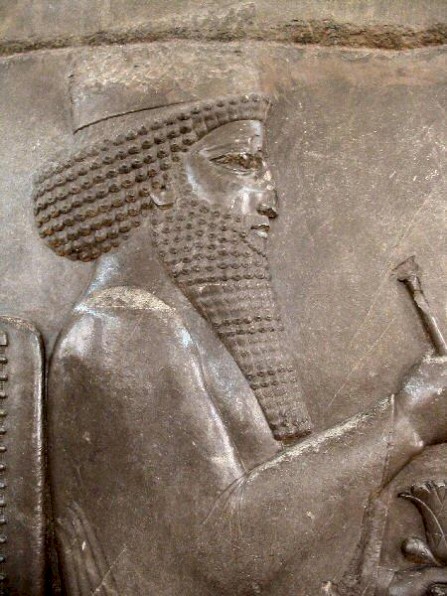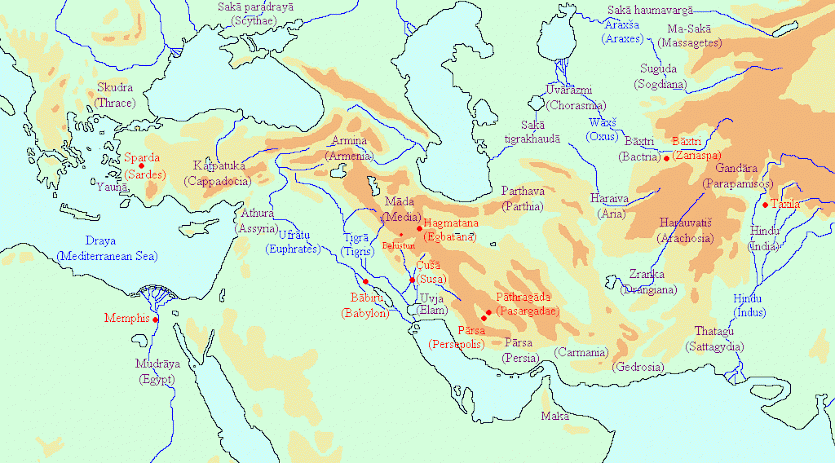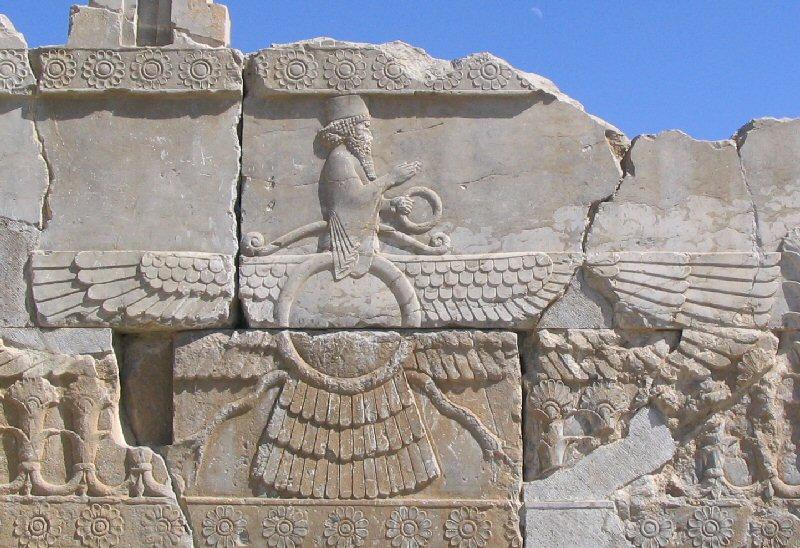Darius the Great: Civil War
Darius I (Old Persian Dârayavauš): king of ancient Persia, whose reign lasted from 522 to 486. He seized power after killing king Gaumâta, fought a civil war (described in the Behistun inscription), and was finally able to refound the Achaemenid empire, which had been very loosely organized until then. Darius fought several foreign wars, which brought him to India and Thrace. When he died, the Persian empire had reached its largest extent. He was succeeded by his son Xerxes.
First phase: Babylon

As we have already seen above, the killing of Gaumâta on 29 September 522 was seen as a sign for revolt in many subject countries. A man named ššina immediately proclaimed himself king of Elam, and Nidintu-Bêl became king of Babylon, which had lost its independence only seventeen years ago. He claimed to be the son of the last king Nabonidus and called himself Nebuchadnezzar III, after the famous ruler who had created the Babylonian Empire. Persian sovereignty had never been challenged in a similar way.
Darius and his allies were still in Media, where Gaumâta had been killed. Probably, the army that Cambyses had gathered to conquer was still intact, and this gave Darius some advantage. He immediately moved to the south, must have passed through Ecbatana and along the rock of Behistun, and reached the Tigris near Opis, where Cyrus had once defeated Nabonidus. Undeterred by this ominous location, the Babylonians tried to stop the invaders from entering their country. Darius describes the struggle:
The army of Nidintu-Bêl held the Tigris; there it took its stand, and on account of the waters the river was unfordable. Thereupon I supported my army on inflated skins, others I made dromedary-borne, for the rest I brought horses. Ahuramazda brought me help; by the grace of Ahuramazda we crossed the Tigris. Then did I utterly overthrow that host of Nidintu-Bêl.note

Darius' victory, on 13 December, must have been impressive. He sent an envoy to the capital of Elam, Susa, to demand the extradition of ššina. The Elamites immediately did what had been ordered. This can be deduced from the relief above the Behistun inscription, which shows Darius' opponents in the sequence of their death; as ššina is standing before Nidintu-Bêl, who was defeated in the last days of December, the Elamite leader must have been brought to Darius between, say, 19 and 29 December. Darius personally killed the rebel.
Meanwhile, the Persian army rapidly approached Babylon. According to Herodotus, whose story can be read here, the siege was difficult, and the town was finally taken by a stratagem. Zopyrus, the son of Megabyzus, one of the seven conspirators, mutilated himself, left the Persian camp, went to Babylon, told how he had unjustly been punished by Darius and wanted revenge, was trusted by the Babylonians, and was placed in command of their army - with disastrous results.
The truth is different. On 18 December, the Babylonians were again defeated in the neighborhood of their city, which was captured immediately. Nidintu-Bêl tried to flee but was taken captive. "Then I slew that Nidintu-Bêl in Babylon," as Darius says. He must have believed that the civil war was over, but he was wrong.
Second Phase: Winter
While I was in Babylon, these provinces revolted from me: Persia, Elam, Media, Assyria, Egypt, Parthia, Margiana, Sattagydia, and Scythia.note
It was a chain reaction of revolts, and this list is not complete, because the satrap of Lydia, Oroetus, started to behave rather independently, and the Median revolt spread to Armenia and Sagartia. This was the largest revolt. Even Herodotus, who ignores the civil wars after Darius' accession, alludes to the rebellion of the Medes. The Elamite insurrection, led by one Martiya, was not a serious matter - the Elamites themselves put an end to it. The rebellion of Vahyazdâta in Persia, on the other hand, was probably the most dangerous, because it undermined Darius' claim to the throne. Vahyazdâta was recognized in the Persian heartland and could send out armies. On the other hand, Darius' situation was not without hope. Darius' father Hystaspes was satrap in Parthia, and his colleagues in Bactria and Arachosia, Dâdarši and Vivâna, remained loyal too. The latter was able to ward off an army sent by Vahyazdâta (already on 29 December).
Everything depended upon the situation in Media, the central part of the Persian empire, now ruled by a man named Phraortes, who descended from one of the Median leaders of old, Cyaxares. If Darius was able to recover this part of the Persian empire, he could isolate the other centers of resistance. However, a large part of his army consisted of Medes, whose loyalty was doubtful. He would have to find new soldiers, but could not recruit them in Persia, which had sided with Vahyazdâta. If, on the other hand, Phraortes remained king of Media and could cooperate with the other rebels, the Persians were chanceless.

The winters of western Iran are cold and wet. Snow covers the mountain passes and it is impossible for armies to move. Yet Darius claims in the Behistun inscription that one of his generals, Hydarnes (one of the seven conspirators), was able to occupy the passes between Media and the Persian heartland, between the territories occupied by Phraortes and Vahyazdâta.
A possible explanation is that he had not been sent away by Darius from Babylon, but from Media. If this is correct, Darius must have sensed immediately after his accession that men like Vahyazdâta would cause trouble in the Persian heartland, and had already sent Hydarnes to control the region. He had almost reached Persia when he hard that Media had revolted, and decided to stay where he was, in the mountain area, where he could prevent the two rebels from making contact.
On 12 January, the Medes stormed Hydarnes' position near Maruš (Mehriz, 30 kilometers south of modern Yazd). Although the Medes counted 3,827 (or 5,287) dead and had to see how 4,329 men were taken prisoner by Hydarnes' men, the Persian victory was not as complete as Darius' words ('my army utterly defeated that rebel') suggest. Hydarnes moved his army to Kampanda, which is 60 kilometers southwest of modern Yazd. Here he controlled the road between Persia's capital Pasargadae and Gabae (Isfahan). It was a defensive position, but he had prevented that Phraortes and Vahyazdâta joined forces.
A similar action took place in the north. Here, Armenia sympathized with the Median revolt. If Armenia would fall into Phraortes' hands, he could make contact with Cappadocia and the rebellious satrap of Lydia. It was important to prevent this, and therefore, Darius sent Vaumisa to the north. Although he won a victory on 31 December, he was unable to continue his march to the north. Yet, he was able to stay in the region and prevent Phraortes from making contact with the Armenian rebels.
Finally, it should be mentioned that in the east, there were loyal Persians who fought bravely for Darius. His father Hystaspes managed to ward off an attack by Parthians (8 March), and Dâdarši, the satrap of Bactria, remained loyal. In Arachosia, Vivâna was not only able to defeat an army sent by Vahyazdâta of Persia (above), but was also able to seize the tactical initiative. He defeated his enemies a second time near modern Kandahar, and pursued Vahyazdâta's forces.
Summing up: Hystaspes, Dâdarši and Vivâna continued to occupy regions east of Media. Phraortes may have wanted to move to the west, but was unable to do so, because he had to secure his rear. At the same time, Hydarnes threatened his southern front, and Vaumisa, although less successful than Darius may have hoped, was too dangerous to the Median cause to ignore. In the spring, the Persians would restore order in Media and the Persian heartland. The seeds of their victory had been sown in the winter.
Third phase: Phraortes
During the winter, which he spent in Babylonia, Darius prepared for the big attack on his two main enemies: Phraortes of Media and Vahyazdâta of Persia. In April, he was ready to strike with a large force. His aim was Media, the center of all trouble. A man named Uštânu was left behind as satrap of Babylon, and a second army, commanded by Artavardiya, marched to the Persian heartland. It has been assumed that this army was made up from Median soldiers, which Darius could not use during his attack on Media. His own army must have consisted of Persians and volunteers from the west.
In the first week of May, Darius met the army of Phraortes.
I went forth from Babylon and came into Media. When I had come to Media, that Phraortes, who called himself king in Media, came against me unto a city in Media called Kunduruš [Kangavar?] to offer battle. Then we joined battle. Ahuramazda brought me help; by the grace of Ahuramazda did my army utterly overthrow that rebel host. On the twenty-fifth day of the month Adukanaiša we fought the battle [8 May 521]. [...] Thereupon that Phraortes fled thence with a few horseman to a district in Media called Rhagae [Tehran]. Then I sent an army in pursuit. Phraortes was taken and brought unto me. I cut off his nose, his ears, and his tongue, and I put out one eye, and he was kept in fetters at my palace entrance, and all the people beheld him. Then did I crucify him in Ecbatana; and the men who were his foremost followers, those at Ecbatana within the fortress, I flayed and hung out their hides, stuffed with straw.note
Darius claims that he made 18,000 prisoners. This was not the end of the matter, however. One of Phraortes' relatives, a man named Tritantaechmes, continued the struggle from Sagartia. But the tide was turning against the rebels. A Median officer in Darius' army named Takhmaspâda went after Tritantaechmes and captured him. The Sagartian leader was mutilated and crucified at Arbela.
Meanwhile, the other Persian armies were moving too. Artavardiya defeated Vahyazdâta of Persia on 24 May and pursued his opponent to the east. A commander named Dâdarši (not the same as the satrap of Bactria) now invaded Armenia, where he made contact with the earlier invasion army, commanded by Vaumisa (above). Victories were reported on 20 May, 30 May, 11 June, and 20 June.
Everywhere, the resistance against Darius was coming to an end. The Parthians, who had attacked his father Hystaspes during the winter, were trapped between two forces: from the east, Hystaspes and Dâdarši of Bactria, and from the west, the army of Darius himself, which had just defeated Phraortes. On 11 July, the Parthians surrendered. Four days later, Vahyazdâta of Persia was arrested. He was mutilated and, 'together with the men who were his chief followers, crucified in a city in Persia called Uvâdaicaya'.
Fourth Phase: The Last Resistance
Darius was now supreme ruler of the Persian empire. To inspect his new kingdom, he visited Persia (where he must have been inaugurated as king in Pasargadae), received the surrender of the rebel leader of Elam, and returned to Media. Here, he learned that the Babylonians had revolted again, but he did not go there in person.
A certain man named Arakha, an Armenian, son of Haldita, rebelled in Babylon. At a place called Dubâla, he lied unto the people, saying: 'I am Nebuchadnezzar, the son of Nabonidus.' Then did the Babylonian people revolt from me and they went over to that Arakha. He seized Babylon, he became king in Babylon. [...] Then did I send an army unto Babylon. A Persian named Intaphrenes, my servant, I appointed as their leader, and thus I spoke unto them: 'Go, smite that Babylonian host which does not acknowledge me.' Then Intaphrenes marched with the army unto Babylon. Ahuramazda brought me help; by the grace of Ahuramazda Intaphrenes overthrew the Babylonians and brought over the people unto me. On the twenty-second day of the month Markâsanaš [27 November] they seized that Arakha who called himself Nebuchadnezzar, and the men who were his chief followers. Then I made a decree, saying: 'Let that Arakha and the men who were his chief followers be crucified in Babylon!'note
There is something odd about these words. The Behistun inscription is a very stereotypical text. All wars are described in the same words. This war, however, is an exception; where we usually read 'by the grace of Ahuramazda did my army utterly overthrow that rebel host', we now read 'by the grace of Ahuramazda did Intaphrenes overthrow the Babylonians'. It is not clear what this means, if it is significant at all. (It may be a scribal error.) But it is also possible that Darius does not say 'my army' because the army under command of Intaphrenes was not the king's army. It may have been recruited by Intaphrenes himself. This may explain why Darius wanted to get rid of him (above).
Every resistance against Darius was now suppressed. Dâdarši of Bactria put an end to the last revolt, that of Frâda, a rebel leader in Margiana, on 28 December 521, after a march of three hundred kilometers through the Karakum desert. According to the Persian lunar calendar, which contained a leap month in Darius' first regnal year, the nineteen battles -from the Tigris to Margiana- had been fought in one single year. Admittedly, there were still centers of resistance on the brink of the empire, but Darius' men made quick work of them. There was an Elamite insurrection in 521/520, but Gobryas, Darius' father-in-law, restored order. At the same time, Oroetus, the satrap of Lydia who was becoming dangerously independent, was punished, and Otanes (one of the seven conspirators) succeeded him. He added Samos to the Persian empire, where Syloson was made tyrant (more) Finally, a group of Scythians received a new king in 520/519.
Order had been restored in the ancient Near East. Far away from the Persian court at Susa, on 16 February 519, the Jewish prophet Zechariah had a nightly vision: he saw a man on a red horse, commanding a host of heavenly horsemen. An angel explained to Zechariah what he saw: God had sent out these riders to see what had been going on.
And they reported to the angel of the Lord [...]: 'We have gone throughout the world and found the whole world at rest and in peace.'note